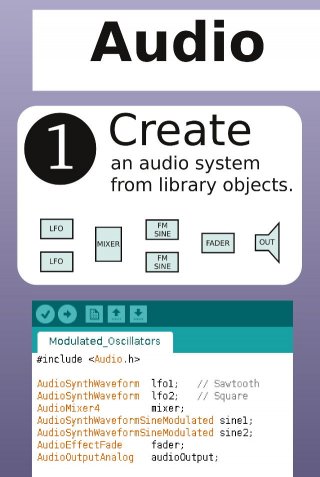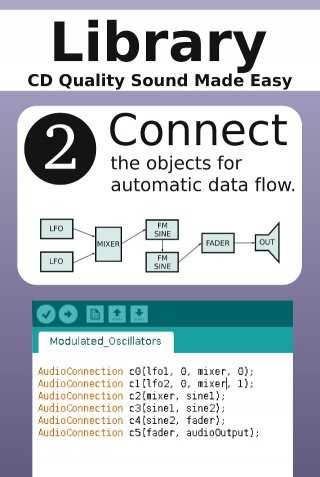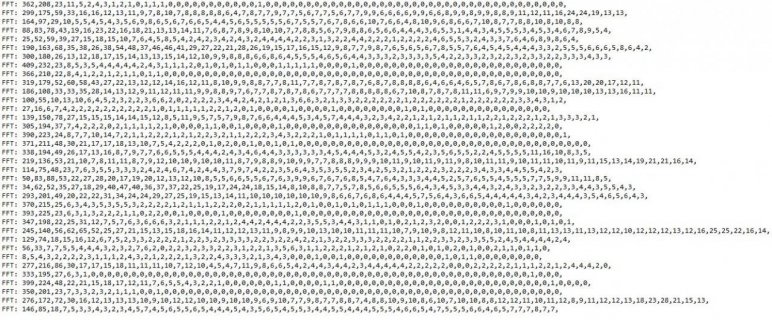#include <Audio.h>
#include <Wire.h>
#include <stdio.h>
#include <SPI.h>
#include <SD.h>
#include <Metro.h>
#include "Tone.h"
//___________________________________________________________________________________
/////////////////////////
//AUDIO CONFIGURATION
int ToneFilter1[]={0,0,0,0,0,0,0};
int ToneFilter2[]={0,0,0,0,0,0,0};
int ToneFilter3[]={0,0,0,0,0,0,0};
int updateFilter[5];
//const int myInput = AUDIO_INPUT_LINEIN;
const int myInput = AUDIO_INPUT_MIC;
AudioInputI2S audioInput; // audio shield: mic or line-in
AudioSynthWaveform osc1;
AudioSynthWaveform osc2;
AudioSynthWaveform osc3;
AudioMixer4 mixSources;
AudioFilterBiquad formantFilter1(ToneFilter1);
AudioFilterBiquad formantFilter2(ToneFilter2);
AudioFilterBiquad formantFilter3(ToneFilter3);
AudioMixer4 mixFormants;
AudioOutputI2S audioOutput; // audio shield: headphones & line-out
// Create Audio connections between the components
AudioConnection c1(audioInput, 0, mixSources, 0); // ************* this line causes the problem ****************
AudioConnection c2(osc1, 0, mixSources, 1);
AudioConnection c3(osc2, 0, mixSources, 2);
AudioConnection c4(osc3, 0, mixSources, 3);
AudioConnection c5(mixSources, 0, formantFilter1, 0);
AudioConnection c6(mixSources, 0, formantFilter2, 0);
AudioConnection c7(mixSources, 0, formantFilter3, 0);
AudioConnection c8(mixSources, 0, mixFormants, 0);
AudioConnection c9(formantFilter1, 0, mixFormants, 1);
AudioConnection c10(formantFilter2, 0, mixFormants, 2);
AudioConnection c11(formantFilter3, 0, mixFormants, 3);
AudioConnection c12(mixFormants, 0, audioOutput, 0);
AudioControlSGTL5000 audioShield;
// sopran a
void setSopranA() {
// calcBiquad(FilterType,FrequencyC,dBgain,BW,QuantizationUnit,SampleRate,int*);
calcBiquad(FILTER_BANDPASS,800,0,0,0.5,2147483648,44100,updateFilter);
formantFilter1.updateCoefs(updateFilter);
calcBiquad(FILTER_BANDPASS,1150,-6,0,0.4,2147483648,44100,updateFilter);
formantFilter2.updateCoefs(updateFilter);
calcBiquad(FILTER_BANDPASS,2900,-32,0,0.3,2147483648,44100,updateFilter);
formantFilter3.updateCoefs(updateFilter);
}
//___________________________________________________________________________________
void setup()
{
Serial.begin(57600);
//___________________________________________________________________________________
// Audio connections require memory to work. For more
// detailed information, see the MemoryAndCpuUsage example
AudioMemory(15);
audioShield.enable();
audioShield.inputSelect(myInput);
audioShield.volume(90);
mixFormants.gain(0, 0.0001);
mixFormants.gain(1, 0.5);
mixFormants.gain(2, 0.5);
mixFormants.gain(3, 0.5);
mixSources.gain(0, 0.3);
mixSources.gain(1, 0.3);
mixSources.gain(2, 0.3);
mixSources.gain(3, 0.3);
osc1.set_ramp_length(88);
osc2.set_ramp_length(88);
osc3.set_ramp_length(88);
osc1.amplitude(0);
osc2.amplitude(0);
osc3.amplitude(0);
osc1.begin(0.1,tune_frequencies2_PGM[30], TONE_TYPE_SQUARE);
osc2.begin(0.1,tune_frequencies2_PGM[37], TONE_TYPE_SQUARE);
osc3.begin(0.1,tune_frequencies2_PGM[44], TONE_TYPE_SQUARE);
setSopranA();
Serial.println("audio setup done");
}
//___________________________________________________________
//Metros
Metro MonitorMetro = Metro(1000);
Metro VolMetro = Metro(10);
// audio volume
int mainVolume = 0;
int oldValue = 0;
void loop() {
//___________________________________________________________________________________
//AUDIO
// volume control
// every 10 ms, check for adjustment
// volume control
// every 10 ms, check for adjustment
if (VolMetro.check() == 1) {
int n = analogRead(15);
if (n != mainVolume) {
mainVolume = n;
audioShield.volume((float)n / 10.23);
}
}
//////////////////
//Mem and CPU Usage
/*
For PlaySynthMusic this produces:
Proc = 20 (21), Mem = 2 (8)
*/
if (MonitorMetro.check() == 1) {
Serial.print("Proc = ");
Serial.print(AudioProcessorUsage());
Serial.print(" (");
Serial.print(AudioProcessorUsageMax());
Serial.print("), Mem = ");
Serial.print(AudioMemoryUsage());
Serial.print(" (");
Serial.print(AudioMemoryUsageMax());
Serial.println(")");
}
}





